#kpelle
Explore tagged Tumblr posts
Text

Kpelle dancer, Liberia, by Liberia Tourism
#kpelle#liberia#africa#folk clothing#traditional clothing#traditional fashion#cultural clothing#western africa
282 notes
·
View notes
Text

“West Africa Liberia Kpelle Tribe potter decorating clay pots before cooking them”
158 notes
·
View notes
Note
You write a lot of characters from very diverse backgrounds (the Pax kids, Calex, Euna and Joey, etc) but you still manage to include details from their cultures that really show their connection to it. What kind of research do you do to be able to represent them well?
THANK YOU FOR YOUR ASK ANON!
*cries with relief that you're asking this instead of asking me why I'm so bad at it*
I am terrified of misrepresenting cultures. Someone I informally use as a sensitivity reader has told me that I overthink this. I screw up. A lot. Cultures can alter drastically depending on the geography and time frame. Sometimes I can't find anything on certain ethnic groups and other times I'm scared of misappropriating something. The last thing I want to do is hurt someone with how I portray something. But, I really want to have a diverse group that can connect with a lot of people, and would rather me told when I make mistakes so i can correct them, then not try.
Short answer: asking millions of questions and doing dumb amounts of research that STILL won't be enough.
Long-winded answer is below.
Where I... cheat? (Can skip to see where I don't)
Euna, Joey
I used to date a woman who is Korean, have two friends who went to teach in Korea, and live beside one of the biggest Korean immigration points in my country. Many a shopkeep has made fun of how bad my accent is when I try a little, "감사합니다," as I offer my payment with my right hand, left hand touching my elbow.
Korean culture is the only culture, so far, where I had someone speak out against how I represented a facet. I debated on altering the scene, and spoke with three cultural informants about this who said it was fine. However, it is something I am altering in the remake of the series that will ONE DAY happen.
Hiro, Yoshida
I have a friend who taught in Japan for a long time and speaks fluent Japanese. He's been an invaluable aid for both of them!
Flynn
I took Mandarin and college and had a VERY patient professor with my millions of questions. Also, I had a Cantonese friend who could give me some information about how it was for his family (different region though!)
Merry, Mercedes, Zaneera (and a little bit of Calex and Lapis)
(You don't know Zaneera yet.) This is several fold. I used to love studying religions when I was younger, so that has helped. I used to tutor and I owe a great debt to the Indian family that took me in and would have proper chai and homemade meals with me. They were not from the same district as Merry. I intentionally picked an underrepresented region for Merry, since most Indians portrayed are from Northern districts. However, I feel like I haven't been able to do proper research there and have been considering picking different districts for her parents, for fear of generalizing and misrepresenting.
My sister-in-law happens to be Pakistani Muslim and most of my brothers friends are from Pakistan or India (or... randomly proud country rednecks. His parties are, um, disjointed at times.) I absolutely adore her Amma and she's very patient answering my sheepish questions about her religion and culture. My sister-in-law also used to do a lot of work in West Africa and in Egypt.
One of my friends went to Granada, Spain, and provided information on Mercedes' hometown.
Where I flail and pray I don't screw up: The Real Research
Calex
I hit the books and newspapers and blogs a lot for Calex. He's one of the hardest ones to balance out all the facets that are nothing like my life experience. And. I got him wrong version one. Very. very. very. wrong. Embarrassingly. No one called me out, but I'll call myself out right here:
The original ethnic group he's part of was the Yoruba people. THAT ETHNIC GROUP IS MOSTLY IN NIGERIA, BENIN, AND TOGO. NOT LIBERIA. THERE ARE TWO WHOLE COUNTRIES WEDGED BETWEEN LIBERIA BEFORE YOU HIT ONE OF THOSE COUNTRIES. (In my corner of ignorant shame)
I didn't want this to happen again.
For the remake, Calex's ethnic group is now the Kpelle. I have.... loads of books on the Kpelle now. But, unfortunately, most of the research I found is decades old, and written by people who aren't always friendly to Liberia as a country. (Either Europeans or African countries that historically don't get along with their far neighbors.) So, um, I subscribe to a Liberian news blog. For Calex, I needed to research, trying to be aware of bias and bigotry...
Kpelle society
Liberian society, economy, etc
the Second Liberian Civil War
Sierre Leone's Civil War (they're neighbors)
The Ebola Out Break of 2014
Racism in Britain
Football clubs in Britain
British culture and slang (according to 2014. Gods it has changed so much already)
Mixed race and religion families in Britain
Racial theory on exoticizing and fetishization of black individuals
This involved preliminary research with, honestly, kids books to get a broad, sweeping scope of things, then digging deeper with adult books, then digging into academic articles for specific information. I'm still struggling with information about Kpelle religion. In the remake, I like to read authors who are West African that eventually settled in Britain before I write Calex's point of view. Liberian Journalists are also great for this (thank you Helene Cooper!) There's SO much more information out there today, and I'm excited to hop back into researching once I'm done with TFMO!
Ajax Pax and Axel Pax
These boys.
These gd boys.
Okay, so I went to Belize. I was really lucky and fortunate that I was in a situation where I could go. And I know I still don't have everything right. I lucked into our tour guide being Maya. No one had ever asked him questions about the modern day culture, and he was so kind with all the questions that I had. I was... gods, that person on the bus. Super obnoxious. Hand going back up as soon as he had time to breathe.
Maya people are treated as second or third class citizens in Belize. Their culture was being eradicated by some of the prostheliziation happening in the area. (Okay, hear me out: modern day Catholics often don't mind melding with other religions. Check out Vodou Catholicism as a great example of this. Not all, but most Protestant religions will often stomp out localized religions when they come in. Around the time that Axel and Pax leave Belize, Protestantism is stepping in and knocking out things like the Deer Dance. Fortunately, Maya cultural groups are fighting back against this and preserving it.) Their beautiful ancient dig sites are also often plowed over and dug up to make new, fancy tourism spots for rich, predominatelywhite travelers. This is actually where some of Santiago and Frasco's character development comes in.
The only original documents I could find on Mopan Maya were in Spanish. So, uh, I started trying to learn Spanish to learn Mopan Maya. So, with the boys, I looked into....
Belizean Creole
Mopan Maya society and culture
Ancient Maya history and rituals
culture and history of Belize, how their tourism industry affects that culture
Spanish
Latin American and Caribbean drug trade (Santiago)
Racism against Indigenous populations, both in Belize and here.
Catholic school systems in Belize
Circus/performance culture, busking, and homelessness.
I also tried to consider how people interact with their culture when they've been separated from it. Being from Belize means a lot to the Pax boys' identities. However, Pax tends to lean more towards identifying as a California kid and a Camp Othrys rebel. Axel, on the other hand, feels very nostalgic for Belize and is reminded of his connection to Maya mythology every time he looks in a mirror or checks his nails. Claws. Nail-claws. Because Pax was younger when he was removed from his home culture, there is a real chance he'll start to lose the ability to speak Mopan Maya if Axel doesn't drill it into him. I have a lot of friends who can understand their home language, but lose the ability to speak it if they don't practice enough. Pax could already be falling into this.
Axel
Okay so look.
You hear, like, two things about Axel's mother. And she should be WAY BIGGER and WAY MORE OF A BADASS.
...... I couldn't find any research on her ethnic group. *hangs head in shame* I've been considering altering her culture of origin to be from somewhere that I can have more research and give her a fuller character design. I've had a wonderful person who is very patient with my book-babbling suggest Maori, since they're very open about sharing their culture.
For all of this Research
I started my research in 2014, TEN YEARS AGO, and did the majority of it about 7-6 years ago. There are SO MANY MORE RESOURCES NOW! *DROOLS* and BLOGS and YOUTUBE CHANNELS! I'm all about verifying resources, but I'm so excited by how much research is out there and how much ethnic groups are getting to share their own cultures and instead of being talked about by those outside of it. My original degree was in cultural anthropology, so this is a passion of mine. Once I'm done with TFMO, I'm really excited to dive back into the newer resources--maybe getting to alter and fix up somethings for the next version of the series!
.... I hope this long-winded rant helped >>''''' Thank you for reading all of it if you made it this far!
6 notes
·
View notes
Text


my little gbandi/kpelle heart is v happy.
1 note
·
View note
Text
Hispanic: Spanish Speaking (Striped Color)
Lusitanic: Portuguese speaking (Striped Color)
Latin American: Latin speaking peoples of Indigenous American, African and European ancestry.
Creol: Peoples of mixed African, European, and Indigenous American ancestry that speak an Afro/Euro pidgin language.
Anglo: English speaking peoples primarily of European descent.
Sierra Leone:
35% temne (Mel)
31% Mende (Mande)
Guinea:
33.9 Fulani (Senegambian / West Atlantic)
31.1% Malinke (Mande)
Guinea Bissau:
28.3% Fulani (Senegambian / West Atlantic)
22.9% Balante (Senegambian / West Atlantic)
Senegal:
38.7% Wolof (Senegambian / West Atlantic)
26.5% Tukulor (Senegambian / West Atlantic)
The Gambia:
33.8% Malinke / Jahanka (Mande)
22.1% Fulani / Tukulor (Senegambian / West Atlantic)
Liberia:
20.3% Kpelle (Mande)
13.4 % Bassa (Kru)
Ivory Coast:
32.1% Akan (Kwa)
15% (Gur / Voltaic)
Togo:
22.2% Ewe (Kwa)
13.4% Kabre / Kabiye (Gur)
Benin:
38% Fon (Gbe)
Nigeria:
30% Hausa (Chadic)
15% Yoruba (Kwa)
15% Igbo (Kwa)
Chad:
30.5% Sara (Bongo–Bagirmi)
0 notes
Video
Dr. Christopher A Bullock March for Education from CALEEB A WATSON on Vimeo.
Dr. Christopher Alan Bullock
Christopher Alan Bullock is a native of Wichita, Kansas, with ancestral roots in the Manchester Community of Arkadelphia, Arkansas. He has dedicated his life to serving his community and promoting social justice. Dr. Bullock's journey in pastoral ministry began at the historic Eighth Street Baptist Church in Wilmington, Delaware. Also, he served as a Delaware State Commissioner on Public Integrity and Commission on Minority Health, actively working towards fostering integrity and promoting the well-being of marginalized communities. Dr. Bullock served as the Pastor of the Progressive Baptist Church in Chicago, Illinois. Recognizing his leadership and commitment to civil rights, he was elected President of the Chicago Southside Branch of the NAACP. Additionally, he was appointed as an Illinois State Commissioner on Discrimination and Hate Crimes, advocating for the rights of individuals facing discrimination. Since 2004, Dr. Bullock has been the inaugural Pastor of the Canaan Baptist Church in Delaware. The mission of Canaan is to do Ministry for the Master. Canaan is a vibrant community welcoming people from various backgrounds, including the Caribbean, South America, and Africa. In 2012, Dr. Bullock achieved another significant milestone when he became the first African American elected New Castle County Council President. In this role, he worked diligently to address community needs and promote equality. Dr. Bullock has also held positions such as president of the Delaware Black Caucus and National Baptist Convention USA, Inc. board member. Dr. Bullock's academic achievements include earning a Doctor of Ministry degree from the United Theological Seminary, specializing in Black Church Leadership in the Urban Context. He pursued further studies at Harvard University Divinity School. Additionally, he holds a Master of Divinity degree from the Colgate-Rochester Divinity School/Crozer Seminary, with a concentration in Black Church Theology. He obtained a Bachelor of Social Work in criminal justice from the University of Alaska-Anchorage. As an author, Dr. Bullock has written two books: "The Social Mission of the Black Church: A Call to Action" and "A Charge to Keep." These works reflect his passion for social justice and challenge the Black church to return to its activist roots. In 2023, Dr. Bullock received a special honor while on a preaching mission in Liberia, West Africa. The Chief of the local Kpelle Tribe gowned him at the Liberian Baptist Convention and bestowed upon him the name "JUTONU," meaning "One who responds." Dr. Bullock has been married to Rev. Dr. Debbie Ardella Strickling-Bullock since 1987. They are blessed with two sons, Benjamin Ellis Bullock and Daniel Alan Bullock, and three grandchildren: Daniel Christopher Bullock, Isaiah Benjamin Bullock, and Isabella Joenelle Bullock.
0 notes
Text
No lies told… pierced my ears at 18, Mom Dukes told me in kPelle how disappointed about 8 generations of ancestors would be. By name.
🤣
70 notes
·
View notes
Text
African Languages With Non Latin Alphabets?
vimeo
So after seeing a tweet by Montel informing everyone that the Yoruba language now unofficially has a written non-Latin syllabary (I kept saying syllabus in the video by mistake) to compliment the oral language I was intrigued.
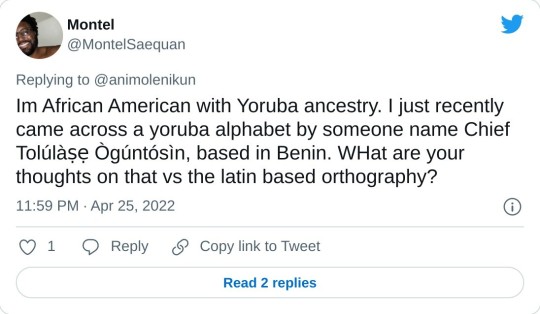
Note: here is the audio version of my reaction via SoundCloud:
I remember being informed that the Fulani (aka Fula) & Kpelle had similar syllabaries so I was very excited to discover that Yoruba had one too.
After further research I discovered that most of the African tribes I am related to have their own syllabary. All of them except Temne developed their own non-Latin written language.
A website called Omniglot catalogues these languages (as well as many around the world) so all I had to do is visit the Omniglot search page, type in my various tribes & become reintroduced to a world I never knew existed.
So here is what I discovered (I encourage everyone to visit Ominiglot for more details about the origins & history of each syllabary).
Yoruba: Odùdwà Alphabet
The Odùduwà alphabet was invented by Chief Tolúlàṣẹ Ògúntósìn from Benin as a way to write the Yoruba language. He claims that he was inspired to create the alphabet in dreams between 2011 and 2016. He also believes that the alphabet was used back in the 12th century by King Odùduwà, who is regarded as the father of the Yoruba people, and was then lost. (Omniglot.com)

Kpelle: Kpelle Syllabary
The Kpelle syllabary was invented during the 1930s by Chief Gbili of Sanoyea in Bong County in Liberia. He was apparently inspired to create it in a dream. It was used by a number of Kpelle chiefs, their scribes and a few others. They used it to write messages, keep records of taxes, stores and debts, and to write a recipe book. Very little of this material survives because of the civil wars in Liberia. It was used at least until the 1980s. (Omniglot.com)

Fula (aka Fulani): Adlam
The Adlam alphabet was created in the 1980s by Ibrahima and Abdoulaye Barry, two brothers from Guinea who decided that their language, Fulani, needed its own alphabet. The name of the alphabet comes from the first four letters, A, D, L, and M. (Omniglot.com)

Mende: Mende Syllabary (Kikakui)
The Mende syllabary was invented in 1921 by Kisimi Kamara (ca. 1890-1962) of Sierra Leone. Seeing how the British managed to take over his country, Kisimi concluded that their power was partly a result of their literacy. He decided to give his own people that ability. Kisimi claimed he was inspired in a dream to create the Mende syllabary, which he called Ki-ka-ku. During the 1920s and 1930s he ran a school in Potoru to teach Ki-ka-ku. The syllabary became a popular method of keeping records and writing letters. (Omniglot.com)

Mandinka: N’Ko
The N'Ko alphabet was invented by Soulemayne Kante of Kankan, Guinea, in 1949. It is mainly used by speakers of Maninka, Bambara, Dyula and their dialects in Guinea, Côte d'Ivoire and Mali. (Omniglot.com)

Although I was disappointed to not discover a Temne Syllabary, I did find out that the Igbo people (I have friends who are Igbo) did have a Syllabary of their own (albeit with a certain dialect).
Igbo: Nwagụ Aneke
The Nwagụ Aneke Script is a syllabary for the Umuleri dialect of Igbo. It was developed in late 1950s by Ogbuevi Nwagụ Aneke, an illiterate land owner and diviner from Umuleri, a village in Anambra State in the southeast of Nigeria. He claimed that spirits of his ancestors revealed the symbols to him. (Omniglot.com)

There are many other African tribes with the own Syllabaries, although unfornately they have faced aggressive resistance from African governments (odd but true) or colonial powers who feared a cultural separation.
I wonder what it would take to revive these languages via written form‽ Hmm…
#africa#african ancestry#yoruba#igbo#kpelle#mandinka#fulani#mende#temne#languages#language#african languages#african#Vimeo#SoundCloud
9 notes
·
View notes
Text

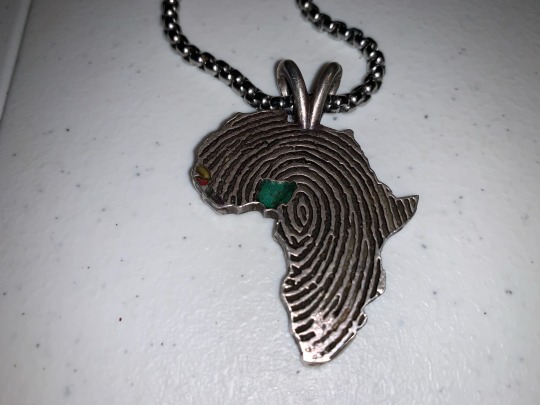
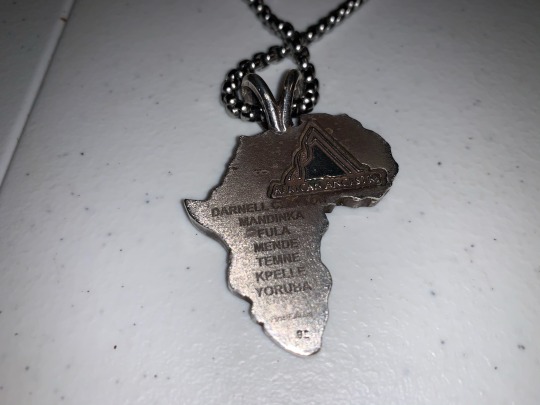
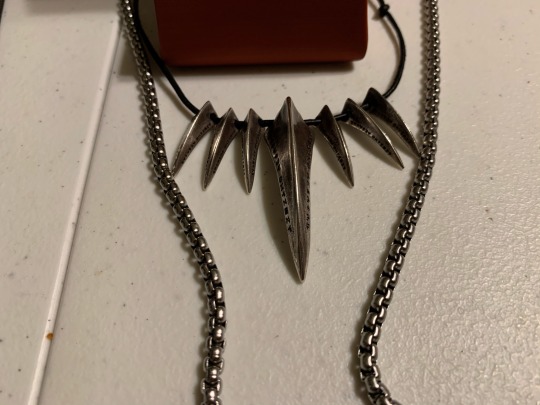
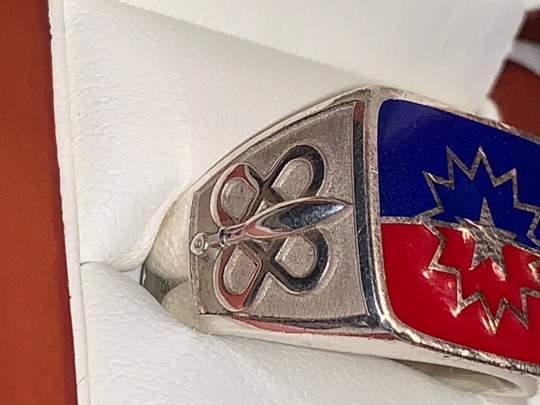
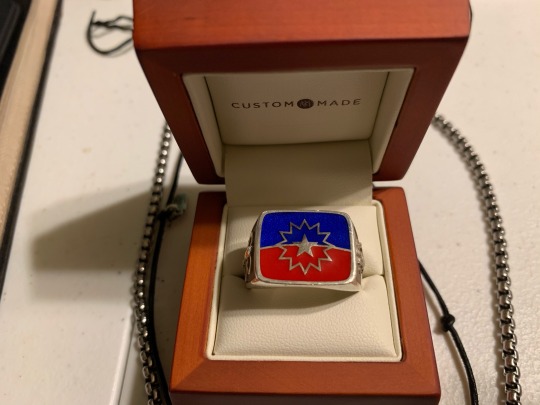

Ever since watching Black Panther in theaters, my interest in wearing African jewelry has dramatically increased, despite previously not being a fan of wearing jewelry.
Perhaps the main reason is because while in the past the item may have looked great, it had no personal value to me & was more of a fashion statement.
These three pieces of jewelry however are unique, as they have personal meaning to me.
African Past
The African Ancestry Heirloom Pendant represents my ancestral past & ancient connections to six precolonial nations (aka tribes) in 5 present day countries:
Mandinka from Senegal 🇸🇳
Fula (aka Fulani) from Guinea Bissau 🇬🇼
Mende & Temne from Sierra Leone 🇸🇱
Kpelle from Liberia 🇱🇷
Yoruba from Nigeria 🇳🇬
I visited the Yoruba people last year (& loved it!) & my desire is to visit the ancestral lands of all of these nations as well as interact with the tribal locals who are blessed to inhabit the region.
African Future
The Wakanda necklace is created by Douriean Fletcher & is based upon the science fiction necklace featured in the movie Black Panther.
The necklace represents to me Africa’s potential as a technological, cultural & political power. It is a future I desire to see achieved in the present world.
The number seven is often seen as a number for completeness as well as perfection & to me represents seven areas Africa as a continent needs to focus on in order to make Wakanda a reality:
Energy (solar, nuclear, wind, etcetera)
Agriculture (plants, animals, distribution)
Mining (refining resources within the continent)
Medical (medicine, surgeries, etcetera)
Communication (internet, television, virtual reality, etcetera)
Finance (banking, a continental currency, etcetera)
Culture (promoting languages, customes, etcetera, within & abroad)
Perfecting each of these would enrich, enlighten & uplift over a billion people privileged enough to live on the continent.
Note: Their is also an either category—space—but that is a given as humanity is destined to build settlements upon other worlds.
African Present
The Juneteenth ring by CustomMade represents the present & I picked three symbols that currently define me.
Juneteenth Flag
The Star represents freedom of Africans in America in not just Texas (where enslaved Africans were freed on June 19th, 1865–hence the name Juneteenth) but in all 50 states.
The Nova Burst is a symbol for a new star or new day, which represents a new beginning for African Americans.
The curve or arc represents a new horizon with promises of new opportunities for African Americans
The colors Red, White & Blue are borrowed from the American Flag, & are a reminder that our enslaved ancestors who built the United States (unjustly without compensation) are Americans.
Credit: CBS 85 & National Juneteenth Observance Foundation
Cross & Crown of Thorns
The Cross & Crown of Thorns represents my spiritual faith which differs from my ancestral faith (more info on that in the next section).
Since there are numerous cross variants from Europe & Africa, I wanted to show case something that was generic as well as specific, which would also transcend cultures as some crosses are specific to certain regions or people groups (Latin, Celtic, Ankh, Cathololic, Protestant have their own variant crosses apparently).
Inspired by Danbury Mint’s Crown of Thorns Cross (which I purchased but rarely wore), the cross represents Jesus Christ’s sacrifice to atone for my sins, while the crown of thorns indicates God’s Kingship which was mockingly acknowledged by the Roman/Italian soldiers who crucified Christ.
The Star in the center indicates how precious the sacrifice was, & the empty cross itself symbolizes that Christ tasted death once & is resurrected forever more (never to repeat that gruesome sacrifice again).
Yoruba Symbol
The Yoruba symbol is borrowed from the (unofficial) Yoruba Flag & is the only tribe I am related to that seems to have an unofficial flag.
To me the sword/staff represents royalty & wealth while the energy beams around around it represent power & prosperity.
Yoruba is not just a language (which I am learning via Genii Games) & culture, but also a pantheistic religion still practices by millions in Nigeria.
Yoruba today are mostly Christian or Muslim, but all are aware of their ancestral beliefs.
O Dabọ
That’s it folks! Yes, this was a lengthy text, but hopefully this explains why I wear jewelry & it’s meaning to me.
#african jewelry#africa#african#african american#african ancestry#jewelry#wakanda#black panther#juneteenth#yoruba#mandinka#fulani#fula#mende#temne#kpelle#senegal#guinea bissau#sierra leone#liberia#nigeria#wakanda forever#christian#Jesus Christ#black jewelry#christianity#african religion#long reads
2 notes
·
View notes
Text
The Lord our Protector (KPELLE, LIBERIA: Bible)
The Lord our Protector (KPELLE, LIBERIA: Bible)
KPELLE, LIBERIA: Bible Psalms (Wule-woo-ŋa) 121 1 Ŋa pâi ŋɛ́i pîlanii ǹyée kɛ́tɛi ma. Mí ƃe ŋá kpɔŋ mâi a pâi kulai naai? 2 Ŋá kpɔŋ mâi a pâi kulâi Yâwɛɛ yêei, nyii ŋ̀elei kpɛ̂tɛ da ǹɔii. 3 Vé pâi ǹɛɛ̂i naa ítoo, íkpɔŋ mâ nuui káa a ŋ̀ɛ́i a tãi kélee. 4 Eezuɛ maa kɔ̃ɔ nuui fá nyîi a ŋuŋ, kpaa máŋ é láa é nyíi. 5 Yâwɛɛ ƃa ímɛi káa-nuui. Gáa íkɔlɛ ma, gɛ́ ímaa kɔ̃̂ɔ. 6 Vóloi fé pâi íkerenîi a ɣele…

View On WordPress
0 notes
Text
The Lord our Protector (KPELLE, LIBERIA: Bible)
The Lord our Protector (KPELLE, LIBERIA: Bible)
KPELLE, LIBERIA: Bible Psalms (Wule-woo-ŋa) 121 1 Ŋa pâi ŋɛ́i pîlanii ǹyée kɛ́tɛi ma. Mí ƃe ŋá kpɔŋ mâi a pâi kulai naai? 2 Ŋá kpɔŋ mâi a pâi kulâi Yâwɛɛ yêei, nyii ŋ̀elei kpɛ̂tɛ da ǹɔii. 3 Vé pâi ǹɛɛ̂i naa ítoo, íkpɔŋ mâ nuui káa a ŋ̀ɛ́i a tãi kélee. 4 Eezuɛ maa kɔ̃ɔ nuui fá nyîi a ŋuŋ, kpaa máŋ é láa é nyíi. 5 Yâwɛɛ ƃa ímɛi káa-nuui. Gáa íkɔlɛ ma, gɛ́ ímaa kɔ̃̂ɔ. 6 Vóloi fé pâi íkerenîi a ɣele…

View On WordPress
0 notes
Photo

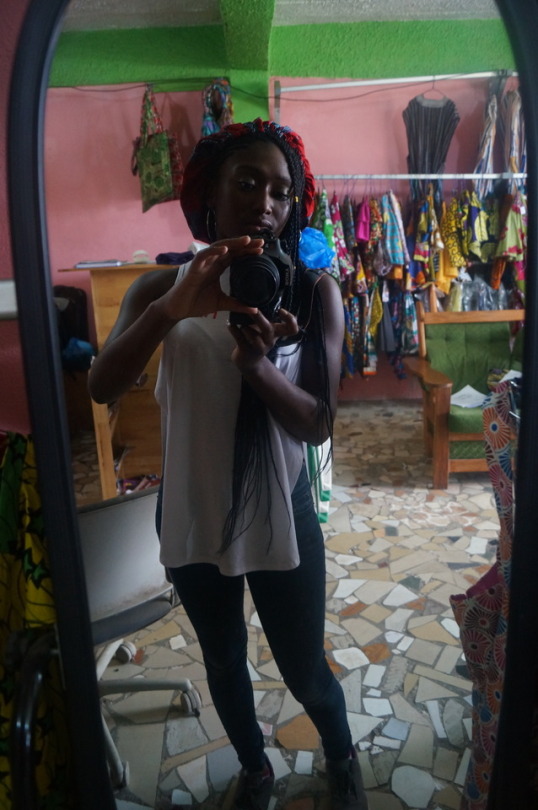
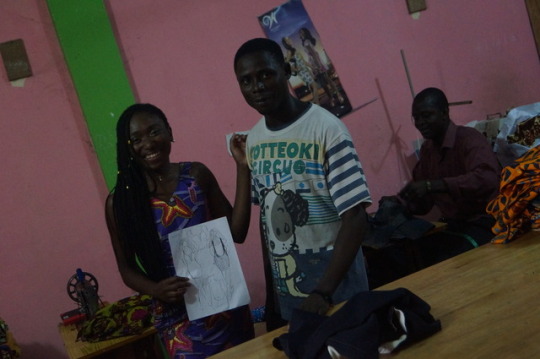
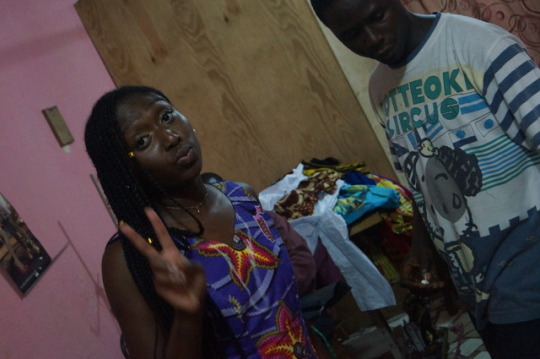
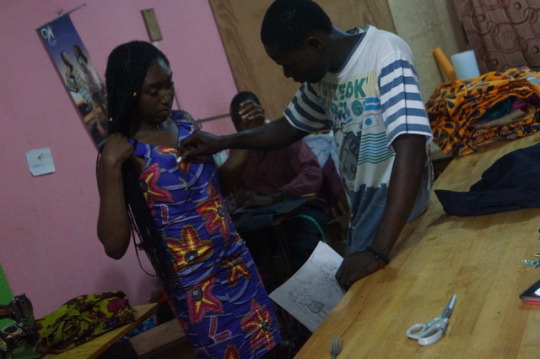

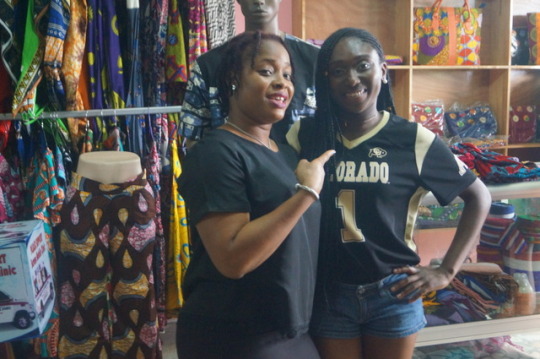
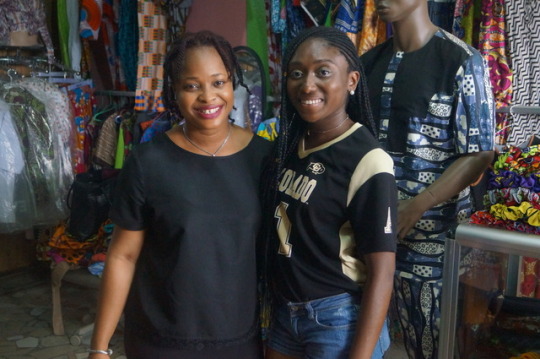
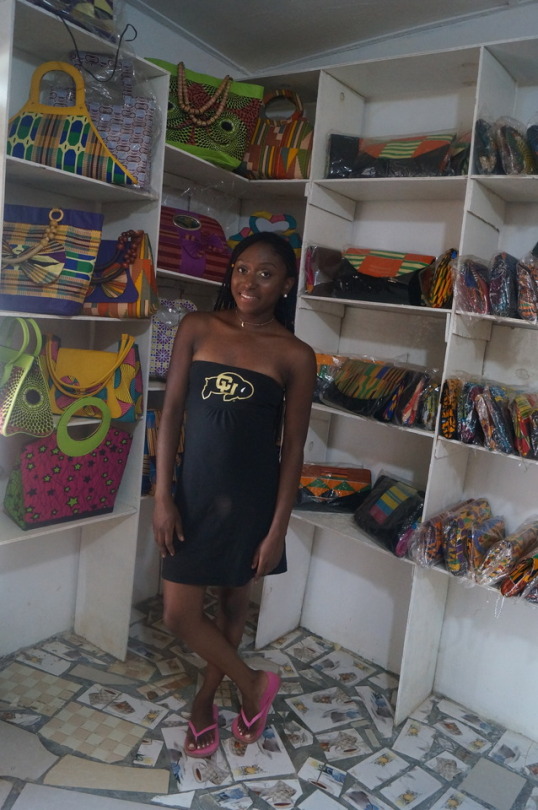
30 Days in Liberia: Completing the “Nymphaea” collection for my brand Guwala da Nele, LLC.
With the help of my university, the University of Colorado Boulder 's CU New Venture Challenge & CU-Boulder Undergraduate Research Opportunities Program (UROP), I have successfully created a collection of garments in Monrovia, Liberia! Upon sales, I plan to come back to with local schools to ensure women and girls have access to computer literacy and STEM skills. I worked with a female tailor shop owner and bought my fabrics from a fabulous lady fabric store owner. I brought my sketches and muslin and these tailors perfectly executed my ideas!
This trip was so surreal. I have been dreaming of being a designer my whole life! I went to fashion school but didn’t take it as seriously as I should have but never lost my passion to make global change one seam at a time. This collection is close to my heart for it lead me to reuniting with my eldest sister from over 7 years since we have last seen each other! It’s given me a chance to see where my parents grew up, talk to people speak out languages and truly immerse myself in my culture. Though it was my first time in Liberia, it certainly wont be my last! I miss you already mama Liberia! See you soon :)
Stay tuned for the collection at the Guwala Da Nele Blog
-Garmai- K. M.
#Liberia#motherland#kpelle#grebo#CUboulder#skobuffs#buffsabroad#UROP#newventurechallenge#NVC#Guwaladanele#GDN#Guwala Da Nele#blackgirlmagic#collection#fashion#fashionschool#Garmai#30daysinliberia
1 note
·
View note
Text
Utoqqatserpunga...
... sivisujaartumik maani sumilluunniit allanngitsunga. Ulapikkama.
My attempt to say: "Sorry ... that I haven't posted anything here recently. I've been busy."
In the meantime I did get the chance to learn and use some #Kpelle in situ, which was a new challenge. In this language, the pronoun changes to mark the tense and mood. And the verb might change tone as well. Tricky!
1 note
·
View note
Text

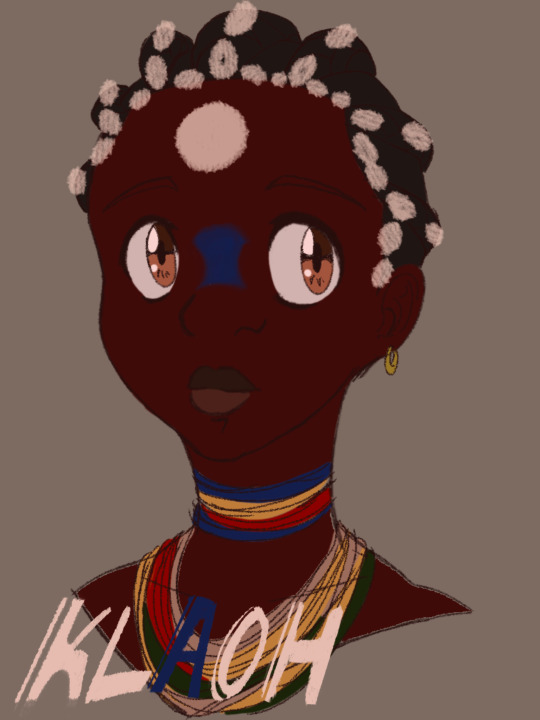


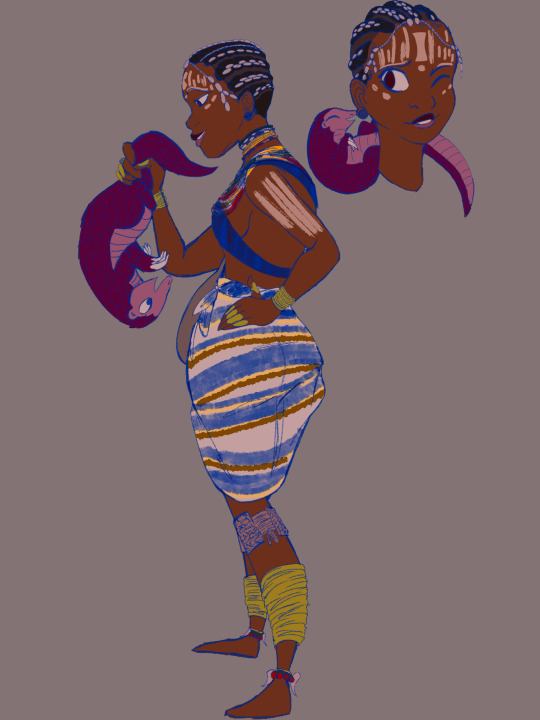
Sketches of beautiful Klao (more commonly known as Kru) girls! It took me forever to find photos that were specifically southeastern Liberian Klao (closer to where my dakwe would be) for accurate reference. I learned about the indigo forehead mark from a Klao journalist’s article so the girls here have it. All the current photos, though, were black and white, so I had to take a guess on some of the colors based on my own real life reference. I really love this and just might make it a series with the Bassa and Vai people, and maybe even the Kpelle. But yeah! I had a lot of fun on this, and I really loved it came out! Just so tumblr doesn’t nuke this post, I did not draw in nipples. It’s stupid but whatever.
Most of their outfits are based off of this photo:
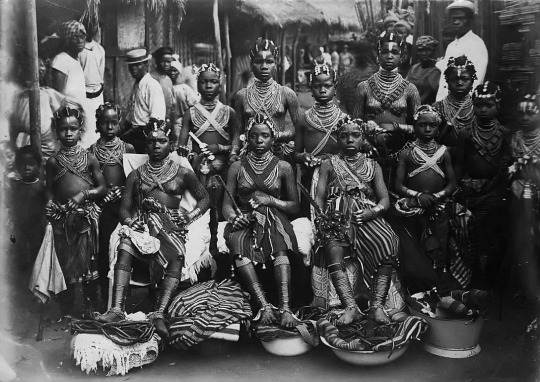
#black artist#African artist#indigenous people#indigenous art#liberia#Klao people#Kru people#niger-Congo#black girl magic#lappa#country cloth#west african#anime girl#black anime#culture#og art#reconnecting indigenous
33 notes
·
View notes
Text


Firestone’s profits after taxes amounted to three times the government’s total revenue for 1951, according to one study. [...] [A]fter the colony declared itself independent in 1847 [...], some of the settlers built Southern-style mansions [...]. Firestone arrived in Liberia in the 1920s. By that time, Harvey S. Firestone Sr., the farm boy from Ohio who founded the Firestone Tire and Rubber Co., had become one of the top industrialists of the gilded age. He dreamed of finding a rubber source beyond the grasp of the British Empire, which controlled much of the world market. In Liberia, he found a spot in the narrow band around the equator where rubber trees thrived – and a nation that was in debt and desperate for business. After two years of negotiations, Firestone and Liberia announced one of history’s great sweetheart deals. Liberia gave Firestone the right to lease up to 1 million acres — roughly 10 percent of the country’s arable land. The cost? Six cents an acre. The term? Ninety-nine years.
[Source: T. Christ!an Miller and Jonathan Jones. “Firestone and the Warlord.” ProPublica. 2014.]


-------
Firestone Liberia, the world’s largest rubber plantation owned by global giant Bridgestone, is alleged to have allowed the continuing release of waste into a river in Liberia, 15 years after it was first alleged of the same pollution problem. [...] Though the initial allegations [were made] in 2005 [...], a report released this month [February 2020] by [...] an environmental campaign group claims very little has changed and accuses Firestone Liberia of corporate negligence. In the report, which follows a March 2019 investigation, communities along Farmington River and close to the Firestone rubber plantation have continued to complain and report contamination of their rivers and wells due to effluent discharged [...].
[Source: Uwagbale Edward-Ekpu. “The world’s largest rubber company is being blamed again for pollution in a Liberia river.” Quartz Africa. 25 February 2020.]



-------
[In 1926] an eight-member scientific team from Harvard University [moved] through the interior regions of Liberia and the Belgian Congo. [...] Over time, the paths of empire, aided by science and medicine, would become well worn, solidifying Firestone’s presence and reach in the Liberian landscape. [...] Disease and rubber had brought the Harvard African expedition to Liberia. In 1926 Firestone Tire and Rubber Company had secured a ninety-nine-year lease for up to a million acres of land from the Liberian government to establish one of the world’s largest rubber plantations. But Firestone faced significant challenges in transforming the tropical rain forest into an industrial plantation. [...] In 1914 Richard P. Strong [had been] recently appointed director of Harvard’s new Department of Tropical Medicine [...]. [I]t was precisely the infrastructures of multinational firms like United Fruit Company, Firestone Tire and Rubber Company, and American petroleum companies overseas that Strong regarded as ideal assets in pursuing the kind of [...] research he envisioned. In 1914, just one year after the creation of Harvard’s Department of Tropical Medicine, Strong took on an additional assignment that cemented the ties between his department and American business interests abroad. As newly appointed director of the Laboratories of the Hospitals and of Research Work of United Fruit Company, he set sail in July 1914 to United Fruit plantations in Cuba, Guatemala, Honduras, Costa Rica, and Panama. [...]
As a shareholder in two British rubber plantations, Strong was acutely aware of the threat that Britain’s rubber monopoly posed to America’s economic interests. Strong approached Harvey Firestone, chief executive of the tire and rubber-processing conglomerate that bore his name, in December 1925 with a proposal to conduct an extensive biological and medical survey of the interior region of Liberia. Strong found a receptive ear. Firestone had negotiated tentative agreements in 1925 with the Liberian government for rights to a 2,000-acre plantation for experiments in rubber production, as well as a 99-year concession to optionally lease up to a million acres of Liberian land for rubber plantations. [...]
The Firestone plantations became an important node in a network of industrial plantations [...]. The paths of empire that sustained the transoceanic exchange of biological specimens, commodities, and knowledge in the growth of industrial plantation economies reached across the Atlantic and extended deep into Liberia’s hinterland. Nowhere is this more apparent than in the expedition footage. Traveling by motorboat up the Du River to the site of the Firestone plantations, traversing the interior by foot with the aid of hundreds of porters, and journeying on roads in the making, all project the reach and anticipatory future of Firestone’s operations in Liberia. [...] Within two decades, the expedition path would become the rubber corridor of Liberia: a 100-mile stretch of road, initially built with corvee labor, that reaches from Harbel, the center of the Firestone plantations, to Gbarnga, the hub of Bong County and the Kpelle people. [...] Roads built to foster Firestone’s connectivity to Indigenous labor served to heighten land alienation. [...] Roads also became the corridors through which profits flowed. In 1951 more than 79 million pounds of raw latex, valued at more than $48 million, moved along the former expedition path. Firestone owned 94 percent of that latex [...].
[Source: Gregg Mitman. “Forgotten Paths of Empire: Ecology, Disease, and Commerce in the Making of Liberia’s Plantation Economy ...” Printed January 2017 in Environmental History. Originally published: December 2016.]




-------
[BJ] runs a tire repair shop in central Liberia that is only 500 meters from a rubber farm, but the tires he fixes were made a continent away. “It hurts me especially when I see tires marked Firestone,” the 30-year-old said. “I look at them and say ‘My God, this rubber comes from right here, and returns to us in finished products.”
[Source: Jonathan Paye-Layleh. “Future for Liberia’s rubber farmers shaky amid economic woes.” AP. 22 August 2020.]

525 notes
·
View notes
Text
Year Of Africanization (2020)
Not so random goals for next year as 2019 comes to a close.
Too Long, Didn’t Read
I intend to obtain citizenship in Sierra Leone based upon my @AfricanAncestry DNA test results as well as register for Ghana’s $0/99 year land lease program.
I love long walks on the beach, as well long videos, podcasts & articles.
Enjoy the show below. 🙅🏾♂️✌🏾👍🏾✊🏾👍🏾
vimeo
Video above & audio below.
For those who prefer to skim, here is the not-so-medium post on Medium.
#africa#africans#sierra leone#ghana#nigeria#guinea bissau#senegal#african ancestry#dna#african#diaspora#african diaspora#mandinka#fula#fulani#mende#temne#kpelle#liberia#yoruba#year of return#2020#goals#black panther#wakanda
1 note
·
View note